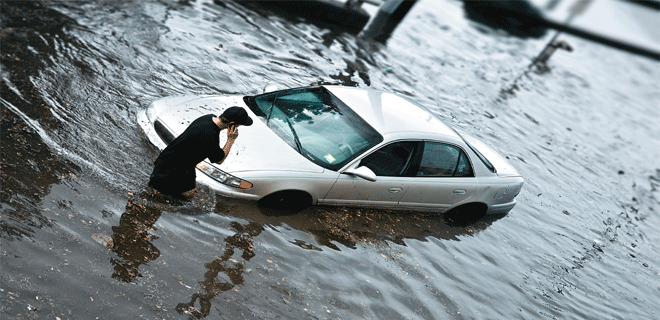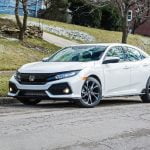He: Hyundai is a latecomer to the booming baby SUV segment, but it has arrived fashionably late with its new Kona – a bold-looking high-riding hatch based on the latest-generation i30. It is available in three trim levels, each with a choice of either a 2.0-litre naturally-aspirated engine, front-wheel drive and a six-speed automatic or a 1.6-litre turbo four-cylinder with all-wheel drive and a seven-speed dual clutch automatic. Pricing starts a bit higher than some of its rivals – and equivalent i30 models – at $24,500 (plus on-road costs) for the 2.0-litre Active with the 1.6-litre AWD configuration commanding a $3500 premium across the range. We’re testing the mid-level Elite with the base engine and front drive layout that costs $28,500 (plus on-roads). First off Dani, what do you make of its interesting style?
She: Extreme styling is becoming trendy for baby SUVs, Amac. Like Toyota’s polarising CH-R, Hyundai’s Kona is set to divide opinion. My husband really likes the external body, but I think it’s too busy. The headlights look awkward and the black body cladding comes off more clunky than rugged. Like many cars in this class, the Kona may be jacked up but it’s not elevated enough to feel like an SUV and for some, that higher riding experience is what adds to the appeal. How did you rate the cabin?
He: I actually like the look of the Kona – it’s certainly something different from Hyundai, and, more importantly, it doesn’t just look like a jacked-up version of the i30 hatch in the same way the Subaru XV is to the Impreza. However, the cabin is far more familiar with a similar design to the i30. That’s no bad thing, as both models brings an increased level of quality not found in previous Hyundais. In the Kona, there’s good storage space, plenty of power outlets to keep a mobile-devouring generation on the run, and its tablet-style multi media screen has the latest in connectivity, including smartphone mirroring. There’s also a nice splash of colour, with the exterior colour transferred into the cabin on the seats, seat belts and air vent surrounds. I like it.
She: I like the interior better than the exterior. It’s modern but not too over the top. I agree, that the coloured seat belts and stitching throughout the cabin add some colour and vibrancy. Space in the rear is a bit snug (however head room is decent) and the boot isn’t every deep. One advantage about being a latecomer to this segment, is that the Kona has all the latest tech.
/editorial/116034/2017-hyundai-kona-elite-739.jpg)
He: Spot on, Dani. Beyond the all-important connectivity gear, the Kona (at least from the Elite level upwards) comes standard with a decent spread of safety gear, including automated emergency braking, forward collision and blind spot warning, lane keeping assistance and a driver fatique monitor. The 2.0-litre engine, with 110kW and 180Nm, isn’t the most modern motor though, and it can feel a little underwhelming out on the open road where it needs revs to get the most out of it. But the six-speed auto is well calibrated to be in the right gear at the right time and keep it on the boil. The 1.6-litre turbo and DSG combination is probably the better pick for those that want something with a bit more spark in the driving character. For those that don’t, this will certainly do the job. What did you think about the way it drives?.
She: I had big expectations of the Kona, given it shares the i30’s DNA. I agree that the transmission shifts reasonably well and the ride isn’t bad, but it doesn’t feel as supple on the road as the smaller, lighter i30 sibling. It’s easy to drive around town, with light steering and reasonable compliance, but the Kona doesn’t seem to adapt to county roads as well, despite localised tuning and suspension for Australian roads. I also thought it had a bit too much road noise on the highway.
He: Maybe that’s a sympton of its higher ride height and Hyundai needing to stiffen-up some of the suspension settings to ensure it sits flat in the bends. It’s a little sharper than the i30 for sure, but I still think Hyundai Australia does a brilliant job of its local tuning program and the Kona is among the best in the class for balancing good levels of comfort with surefooted handling. So, in the end, what do you think of the Kona Dani; has Hyundai’s late entry into the baby SUV segment been worth the wait?
She: I think the Kona is competitively priced and though the design isn’t my cup of tea, it’s overall package provides great value for money in a car that offers a decent driving character. For added incentive, there’s Hyundai’s five-year, unlimited kilometre warranty and capped-price servicing, whereas rivals such as Mazda’s CX-3 and Toyota’s CH-R only offer three years. Hyundai has certainly come of out its conservative shell with its first compact SUV and in this overflowing segment of the market, that’s probably what’s needed.
He: Agree. The Kona’s styling might not be to everyone’s taste, but there’s no denying the South Korean car maker has come along in leaps and bounds with its latest generation of small cars, including this one. I think it has presence on the road, has a funky and functional cabin and drives pretty well – although personally I’d pick the turbo motor and AWD set-up as it offers a bit more poke. All in all, the Kona is up there among the best of the new breed of baby SUVs.
2017 Hyundai Kona Elite Price and Specifications
Price: $28,500 (plus on-road costs)
Engine: 2.0-litre four-cylinder petrol
Power: 110kW at 6200rpm
Torque: 180Nm at 4500rpm
Transmission: Six-speed automatic, FWD
Fuel use: 7.2L/100km
– For more information visit our Hyundai showroom
[“Source-drive”]





